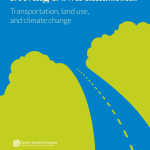New Jersey Future Blog
South Jersey: A New Smart Growth Frontier?
April 7th, 2007 by Tim Evans
- The fastest-growing county in New Jersey between 2005 and 2006 was Gloucester, with a 1.8 percent rise in population last year, according to estimates recently released by the Census Bureau. (Gloucester is also the fastest-growing county so far in the 2000s.) Somerset and Cumberland counties also posted one-year growth rates above one percent; the statewide increase was 0.25 percent. Salem and Ocean counties round out the top five.
- In each of the last three years, the list of New Jersey’s five fastest-growing counties on a year-to-year basis has included at least three South Jersey counties: some combination of Gloucester, Atlantic, Salem, and Cumberland. (And this is not even counting Ocean County as South Jersey.) In contrast, Salem and Cumberland were among the slowest-growing counties in the 1990s; Salem even lost population in that decade, the only county in the state to do so.
- Several counties in northern and central New Jersey that outstripped Gloucester County and most of the rest of South Jersey (except Atlantic County) in the 1990s have seen their growth rates drop off in recent years. Population increases in Ocean, Warren, and Hunterdon counties between 2005 and 2006 were only about half their respective average annual increases of the 1990s; Monmouth County’s 2005 to 2006 increase was only seven percent of its 1990s annual average; and Middlesex County actually sustained a small population loss in the last year, after gaining an average 7,800 people per year between 1990 and 2000.
PA Still Gaining From NJ’s Losses
In the northern and central parts of New Jersey, the story about population growth in recent years has been that the wave has crested and is now depositing new residents mainly in eastern Pennsylvania. This year’s county population figures reinforce that story: Pike and Monroe counties in the Pocono Mountains of northeastern Pennsylvania remain the two fastest-growing counties in the entire northeastern United States between 2005 and 2006—a distinction they have enjoyed all decade, thanks to the ongoing influx of people from New York City and northern New Jersey. Pike County grew by 3.6 percent in the last year (and has grown by 25 percent since 2000), and Monroe grew by 2.0 percent (and by 20 percent since 2000).
Now another eastern Pennsylvania county has joined the list of growth leaders: Northampton County, in the Lehigh Valley along Interstate 78, a major commuter artery into northern and central New Jersey. Its 2005 to 2006 growth rate of 1.4 percent was enough to land it in ninth place in the northeastern United States. Most of its growth is attributable to New Jersey residents leaving the state. (For more on population growth and migration patterns in NJ, read NJF’s research report, “Moving Out.”)
Slowing Growth in Northern and Central NJ
Growth has generally slowed in New Jersey (and throughout the Northeast) in the last few years. In the 1990s, New Jersey gained a statewide average of 66,700 new residents per year. Between 2000 and 2003, the average gain was 72,700, but things have since taken a downward turn, slipping from 43,300 during 2003-2004 to 27,300 for 2004-2005 and down to 21,400 between 2005 and 2006. Between 2003 and 2006, the nation’s population grew by 2.96 percent, but New Jersey’s growth rate was barely a third of that, at 1.07 percent, and the Northeast as a whole posted an even more anemic 0.57 percent growth.
Slowing growth statewide is attributable largely to a population plateau in northern and central New Jersey. Only one county in the entire northern half of the state (Mercer) had yearly population increases between 2003 and 2006 that averaged more than 70 percent of the annual increase in the 1990s. In Monmouth, Union, and Passaic counties, the average annual increases from 2003 to 2006 have been less than 15 percent of what they were in the 1990s. Essex and Hudson counties, after gaining residents in the 1990s and the early 2000s, have returned to losing population, sustaining losses every year since 2002. (Interestingly, these declines are not the result of losses in the counties’ largest cities: Newark’s population has grown consistently since 2000 and Jersey City’s has held steady.)
For most northern and central counties in New Jersey, growth seems to be winding down as a diminishing supply of developable land and a resistance to building new housing (and the resulting inflation of housing prices) chase potential residents westward across the Delaware. In these places, it is increasingly true that the future of development will be redevelopment, that accommodating new residents is going to involve reusing land and buildings that have outlived their initial economic purpose.
Expansion in South Jersey
Not so in the southern half of New Jersey, where home prices remain a relative bargain compared to Philadelphia’s Pennsylvania suburbs, and where the City of Brotherly Love’s lackluster economic performance has meant significantly less development pressure on open space than is the case in the northern half of the state. The much slower-moving Philadelphia growth wave still has room to expand into southern New Jersey.
In only four of New Jersey’s 21 counties have average annual population increases between 2003 and 2006 exceeded average increases in the 1990s: Gloucester, Cumberland, Salem, and Camden—all in South Jersey. Two neighboring southern Gloucester County townships, Woolwich and Harrison, were the second- and third-fastest growing municipalities in the entire state in the 1990s. In addition, the fastest-growing municipalities so far during the 2000s in Salem County are precisely those that are closest to Gloucester County’s hot spot. Coincidence? Or could this be Philadelphia-driven development beginning to spread beyond the edges of Gloucester County into the farm fields of counties even farther south?
In southern New Jersey, the future of development will not only be redevelopment—as in the older suburbs that host Camden County’s PATCO rail line, or along NJ Transit’s River Line through Burlington County’s riverfront towns—but the continued creation of brand-new communities, resulting both from Philadelphia-oriented growth and from the increasing overflow of central New Jersey into still-rural northern Burlington County. State agencies thus need to apply in South Jersey not only everything they’re learning about how to foster good redevelopment, but also the guidelines in the State Plan on how to promote new development in a “center-based” form.
Only two modern examples of this development pattern exist in the state today: Washington Township in Mercer County and Chesterfield Township in Burlington County. Center-based growth needs to become the rule rather than the exception if South Jersey is to make better use of its remaining developable lands than northern and central New Jersey have.
If you have any questions about this issue of Future Facts, please contact: New Jersey Future’s Research Director, Tim Evans.















